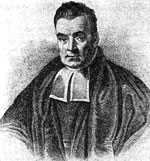Volume 23, Number 1—January 2017
Etymologia
Etymologia: Bayesian Probability
Thomas Bayes (1701–1761) (Figure) was a Presbyterian Minister, and how he become interested in statistics and probability is uncertain. Bayes presented his famous theorem on probability in “An Essay Towards Solving a Problem in the Doctrine of Chances,” which was published posthumously by his friend Richard Price in 1763. Bayes’s theorem provides a method of explicitly including prior events or knowledge when considering the probabilities of current events (for example, including a history of smoking when calculating the probability of developing lung cancer). Bayesian approaches use prior knowledge and information (e.g., probabilities) that may help reduce uncertainty in analysis and have therefore been increasingly adopted by analysts in public health.
References
- Armitage P, Berry G. Statistical methods in medical research. London: Blackwell Scientific Publications; 1994.
- McGrayne SB. The theory that would not die: how Bayes’ rule cracked the enigma code, hunted down Russian submarines and emerged triumphant from two centuries of controversy. New Haven (CT): Yale University Press; 2011.
Figure
Cite This ArticleRelated Links
Table of Contents – Volume 23, Number 1—January 2017
| EID Search Options |
|---|
|
|
|
|
|
|

Please use the form below to submit correspondence to the authors or contact them at the following address:
Ronnie Henry, Centers for Disease Control and Prevention, 1600 Clifton Rd NE, Mailstop E03, Atlanta, GA 30329-4027, USA
Top